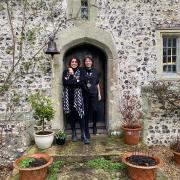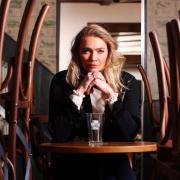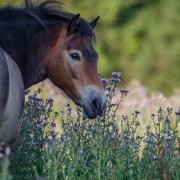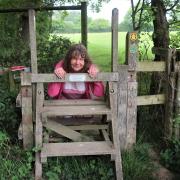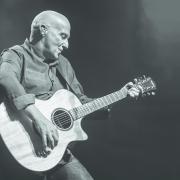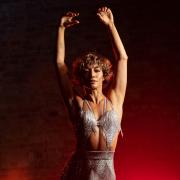John Vernon Lord is among the finest illustrators of his generation. On the publication of his latest illustrated collection, an imaginative and unorthodox take on Alice Through the Looking Glass, Angela Wintle speaks to him at home in Ditchling
John Vernon Lord is among the finest illustrators of his generation, whose popular picture book The Giant Jam Sandwich has become a modern children’s classic, and whose exquisite illustrations to such classics as Aesop’s Fables, Lewis Carroll’s Alice books and Edward Lear’s nonsense verse have become treasured collectors’ items.
But unlike Raymond Briggs, his former teaching colleague at the University of Brighton, Lord is not a household name, despite being universally recognised by the cognoscenti as one of the giants in his field. Why so?, I ask, as we sit chatting in his Ditchling studio, a treasure house groaning with cherished art books and classical CDs.
“Well, this might sound arrogant, but I’ve spent much of my career in teaching, which I’ve loved, and all my illustration was squeezed into Saturdays and Sundays, early morning and late evenings,” he replies, his soft Derbyshire accent betraying his northern roots.
Besides, commercial success has never been paramount to him. He hasn’t done a book with a mainstream publisher for some years now, preferring the high production values of the Folio Society and Artists’ Choice Editions, for whom he’s just completed a fine print edition of Through the Looking-Glass and What Alice Found There. Private presses also free him from mainstream requirements, he adds, allowing him to be more esoteric.
This is plainly evident in his beguiling Alice illustrations, which take a fresh and unorthodox approach to these classic favourites. But it was a daunting challenge, he admits, not least because some 300 illustrators had preceded him. And then there was the small matter of one John Tenniel, Alice’s first and arguably foremost illustrator, whose black and white drawings of the White Rabbit, the Mad Hatter and, of course, Alice herself are etched into the popular imagination.
“When a favourite book comes out in a new illustrated edition, we approach it with eager anticipation and dread,” acknowledges Lord. But wisely perhaps he decided to throw caution to the winds, adopting a radical new approach. So much so, in fact, that he decided to dispense with Alice altogether. Commercial suicide perhaps, but he reasoned there was no point in tackling Alice unless you had a completely new take. And besides, he had a clever idea.
“I wanted to illustrate the books according to a notion of Alice’s thoughts and views of the world,” he says. “You rarely see yourself in dreams, indeed you rarely see yourself at all! And I wanted Alice to be somewhat disembodied while she lay asleep among the field of daisies in her dream-like state. I thought doing without Alice would enable the reader to see the story with fresh eyes.”
With his tall frame, biblical beard and wire-framed glasses, Lord looks every inch the scholar, which is fitting given that he holds the illustrious title of emeritus professor of illustration at the University of Brighton, where he has taught and lectured for 50 years. But he wears his learning lightly and is a down-to-earth and unpretentious man, just as likely to indulge in a little gossip over a pint at his local pub as share his thoughts, say, on the future of illustration.
That is not to say that he doesn’t take his work seriously and has a style all his own, characterised by a love of black and white, influenced by his heroes Gerard Hoffnung and Wenceslaus Hollar. At first sight, his illustrations appear to be traditional wood engravings, but in fact they are all pen and ink drawings. Instead of cutting into a surface to release the light like a traditional engraving, he reverses the process, skilfully building up the dark areas with pen and ink.
Courtesy of a mapping pen and a Rotring, he creates texture with fine crosshatching or parallel lines built up with a ruler, while here and there he waxes the paper to resist the ink, creating sudden explosions of light. Obsessed with numbers and ratios, he often composes his page according to a grid structure and uses the lines created by two overlapping squares as a geometric framework, with the emphasis on vertical and diagonal stresses.
This controlled approach might be considered unfashionable in an age when expression rules, but he makes no apology. “It has often bothered me how some art and design teachers take the narrow view that it is only the freely-drawn line which possesses human emotion and expression,” he says. “It certainly has a particular type of expression, but I also like the cool gravity of something which is quite stiff and architectural. I’ve always liked a degree of detachment.”
The son of a baker and ship’s hairdresser, Lord was born in the Peak District and studied illustration at the Central School of Arts and Crafts where one of his teachers, John Burningham, persuaded him to leave and get started as a freelance illustrator. He made his name when he joined the celebrated team of illustrators at the Radio Times, before marrying and moving to Sussex where, in 1968, he began teaching at Brighton art college (now the University of Brighton).
Around this time he decided to confine his artistic activities to book illustration, producing The Giant Jam Sandwich in 1972, which tells the story of a village’s attempts to rid itself of a menacing swarm of wasps by entrapping them in a giant jam sandwich.
“Isn’t it crusty, aren’t we clever/But the wasps are just as bad as ever,” he chants, gleefully reciting Janet Burroway’s lively accompanying verse. When I ask why he thinks the book has endured, he smiles enigmatically: “If I knew the answer to that, I’d have written hundreds more best-sellers.”
He has lived in Ditchling with his wife Denie for 40 years, and the village, as well as other Sussex localities, have cropped up in several of his illustrations. “We found Ditchling much friendlier than we had expected,” he says, though he is saddened by the decline in the number of shops. “When we arrived, there were two butchers, an ironmonger, clothes shops, greengrocers and four pubs, when now there are just two. The arrival of Tesco and co has created a very bleak high street.”
When I suggest that perhaps the village’s rich artistic heritage might be some consolation, he falls uncharacteristically silent. “I’m not a great fan of former Ditchling resident Eric Gill, though his lettering and invention of typeface designs were superb,” he concedes.
But he is no less critical of his own work and says the illustrative process can be a hellish one as he gradually watches his original grand idea shrink, as he puts it, into a “shrivelled moth”.
“You always think you can improve on a drawing, hoping to achieve the Holy Grail,” he sighs. “When Denie and I looked through all 330 of my Edward Lear illustrations one evening, she asked which I would do again. It quickly dawned on me there were only five I would keep!”
Through the Looking-Glass and What Alice Found There, illustrated by John Vernon Lord, is published by Artists’ Choice Editions. The standard limited edition, from a run of 320 copies numbered and signed by Lord, is priced �98. The special limited edition, from a run of 98 copies, bound with a leather spine and presented in a slipcase with a set of prints signed by Lord, is priced �320. Both are available from Much Ado Books in Alfriston or direct from Artists’ Choice Editions: by ringing 0208 994 9740 or emailing choicebooks@carolmanheim.co.uk.



